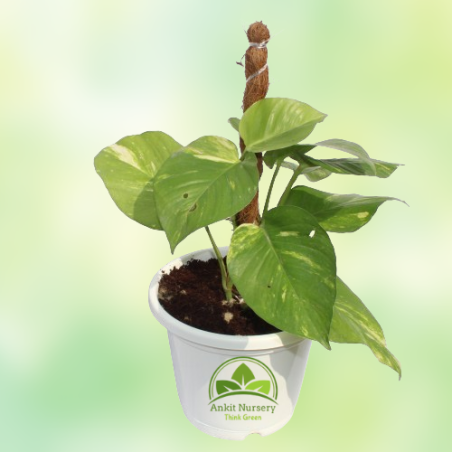
- -10%






The Money Plant, also known as Pilea peperomioides, is a popular houseplant known for its round, coin-shaped leaves and ease of care. Money Plants have round, flat, green leaves that resemble coins, hence the name. The leaves grow on long, thin stems, giving the plant a delicate and elegant appearance.
Money Plants typically reach a height of 12 to 24 inches, though they can grow taller under the right conditions. They have a relatively slow growth rate compared to some other houseplants. Money Plants prefer bright, indirect light. They can tolerate lower light conditions but may become leggy and grow more slowly. Avoid placing them in direct sunlight, as this can scorch their leaves.
Keep the soil consistently moist but not waterlogged. Water the plant when the top inch of soil feels dry to the touch, and allow any excess water to drain away. It's essential to avoid letting the soil become soggy, as this can lead to root rot. Money Plants prefer temperatures between 60-75°F (15-24°C) and moderate to high humidity levels. They can tolerate average indoor humidity but may benefit from occasional misting or placement near a humidifier, especially in dry environments. Use a well-draining potting mix rich in organic matter, such as peat moss or compost. A mix formulated for houseplants or succulents works well for Money Plants.
Feed your Money Plant with a balanced liquid fertilizer diluted to half strength every 4-6 weeks during the growing season (spring and summer). Reduce fertilization in fall and winter when growth slows. Money Plants can be easily propagated from stem cuttings. Simply take a cutting with a few nodes, remove the lower leaves, and place it in a pot with moist potting mix. Keep the soil consistently moist until roots develop.
Prune Money Plants to control their size and shape and remove any dead or yellowing leaves. You can also pinch back the growing tips to encourage bushier growth. Money Plants are not known to be toxic to humans or pets, making them a safe choice for households with children and animals. Overall, Money Plants are attractive and low-maintenance houseplants that can bring a touch of greenery and good fortune to any indoor space. With proper care, they can thrive and be enjoyed for many years.
Dieffenbachia, commonly known as dumb cane, is a popular ornamental plant prized for its...
Indoor plants are a great way to bring nature into your home, purify the air, and enhance your...
Snake Plant Dracaena Trifasciata scientifically known as Sansevieria trifasciata, is not a...
Aglaonema, commonly known as Chinese Evergreen or Aglaonema, is a popular and easy-to-care-for...
Indoor plants are a great way to bring nature into your home, purify the air, and enhance your...
A water plant, also known as an aquatic plant or hydrophyte, is a type of plant that has...
Water plants, also known as aquatic plants or hydrophytes, are plants that have adapted to...
Indoor plants are a great way to bring nature into your home, purify the air, and enhance your...
The term "Syngonium Golden" likely refers to a variety of Syngonium plant with golden or...
The "Song of India" plant is a common name for the Dracaena reflexa var. angustifolia, a...
Dracaena victoria, commonly known as the Victoria plant or Victoria dragon tree, is a popular...
The "Croton Yellow" plant likely refers to a variety of Croton (Codiaeum variegatum) with...
"Chlorophytum" plant, commonly known as the Spider Plant. Chlorophytum comosum, or Spider...
The term "Silver Yucca" is commonly used to refer to a variety of yucca plants with silvery or...
The golden money plant, also known as Epipremnum aureum or Devil's Ivy, is a popular...
Pedilanthus tithymaloides, commonly known as Devil's Backbone or Redbird Cactus, is a species...